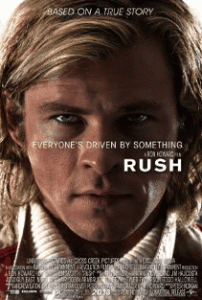
Talk About Ron Howard’s “Rush”
September 18th, 2013 by DavidP
It’s a motorsports axiom that the definitive racing movie has yet to be made. From To Please a Lady and The Racers, to Grand Prix, Winning, Le Mans, Days of Thunder and Driven, gearheads and cinema buffs have found the balance between authenticity and drama (and in the case of Driven, just about everything else) wanting.
Given Ron Howard’s impeccable Hollywood credentials and self-professed fascination with motorsports, hopes ran high his latest offering — Rush — would finally achieve that delicate balance. Based on the 1976 World Championship of Drivers, Rush focuses on the rivalry between the diametrically opposed personalities of defending champion Niki Lauda and challenger James Hunt. While the portrayals of Lauda the automaton and Hunt the playboy are a tad one dimensional, on the whole Chris Hemsworth and Daniel Brühl come-off rather well in their respective roles; particularly Brühl who, from rat-like overbite to skin grafts and clipped Austrian accent, bears an uncanny resemblance to the three time Weltmeister. And if the scenes of Lauda’s hospitalization following his firey accident are gut-wrenching, Hensworth’s portrayal of Hunt battling the demons stemming from his indirect role in that crash is no less compelling.
Too, Rush boasts a dedication to authenticity bordering on the anally retentive when it comes to the uniforms and helmets, race cars and liveries (aside from the Hesketh 308 shown as Hunt’s ride in 1973 when, in fact, he drove a March 731 throughout his rookie F1 campaign).
All the more puzzling then, that the staged on-track action is disappointingly artificial . . . and brief. True, only aficionados will notice or care that Brands Hatch serves as an all-purpose stand-in for Paul Ricard, Interlagos, Jarama, Monza and Fuji. And yes, there are a few snippets shot at the Nordschleife, but the key word is snippets. Otherwise a priceless opportunity to showcase the phenomenal skills and bravery required to pilot an F1 car circa 1976 around some of the world’s most challenging and dangerous road courses is wasted. While that may matter most to hard core race fans, for any viewer the lack of sustained on-track action leaves all the talk about the dangers of racing in the rain at the Nurburgring and Fuji just that: talk.
I get it. Rush is a drama “based on a true story” targeted to a general audience, not a documentary on the 1976 GP season aimed at racing buffs. As such, there’s no room for a seven minute thrill ride around The Green Hell (not “The Graveyard,” Ron). But even a compilation of cars leaping over the crest of the Flugplatz or Pflanzgarten or 30s of in-car segment on the run down the Fuchsröhre or the Adenau descent (or, for that matter, from Westfield through Dingle Dell to Stirling’s Bend) would do more than all the dialogue in the history of cinema to illustrate the challenges of driving a Ferrari 312 T2 or McLaren M23 . . . and the remarkable skill and courage Hunt and Lauda shared in common with their brethren.














































